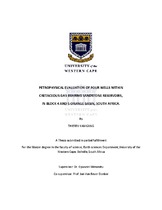| dc.description.abstract | Petrophysical evaluation of four wells within Cretaceous gas-bearing sandstone
reservoirs in blocks 4 and 5 Orange Basin, South Africa.
Thierry Kamgang
The present research work evaluates the petrophysical characteristics of the Cretaceous gasbearing
sandstone units within Blocks 4 and 5 offshore South Africa. Data used to carry out this
study include: wireline logs (LAS format), base maps, well completion reports, petrography
reports, conventional core analysis report and tabulated interpretative age reports from four
wells (O-A1, A-N1, P-A1 and P-F1). The zones of interest range between 1410.0m-4100.3m
depending on the position of the wells.
The research work is carried out in two phases:
The first phase corresponds to the interpretation of reservoir lithologies based on wireline logs.
This consists of evaluating the type of rocks (clean or tight sandstones) forming the reservoir
intervals and their distribution in order to quantify gross zones, by relating the behavior of
wireline logs signature based on horizontal routine. Extensively, a vertical routine is used to
estimate their distribution by correlating the gamma-ray logs of the corresponding wells, but
also to identify their depositional environments (shallow to deep marine).Sedlog software is
used to digitize the results.
The second phase is conducted with the help of Interactive Petrophysics (version 4) software,
and results to the evaluation of eight petrophysical parameters range as follow: effective
porosity (4.3% - 25.4%), bulk volume of water (2.7% – 31.8%), irreducible water saturation
(0.2%-8.8%), hydrocarbon saturation (9.9% - 43.9%), predicted permeability (0.09mD –
1.60mD), volume of shale (8.4% - 33.6%), porosity (5.5% - 26.2%) and water saturation (56.1% -
ii
90.1%). Three predefined petrophysical properties (volume of shale, porosity and water
saturation)are used for reservoir characterization. The volume of shale is estimated in all the
wells using corrected Steiber method. The porosity is determined from the density logs using
the appropriate equations in wells O-A1 and P-A1, while sonic model is applied in well A-N1 and
neutron-density relationship in well P-F1. Formation water resistivity (Rw) is determined
through the following equation: Rw = (Rmf × Rt) / Rxo, and water saturation is calculated based
on Simandoux relation. Furthermore, a predicted permeability function is obtained from the
crossplot of core porosity against core permeability, and it results match best with the core
permeability of well O-A1. This equation is used to predict the permeability in the other wells.
The results obtained reveal that average volumes of shale decrease from the west of the field
towards the east; while average porosities and water saturations increase from the south-west
through the east despite the decreasing average water saturation in well P-A1.
A corroboration of reference physical properties selected for reservoir characterization, with
predefined cut-off values result to no net pay zones identified within the reservoir intervals
studied.
Consequently, it is suggested that further exploration prospects should be done between well
O-A1 and A-N1. | en_US |

